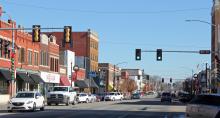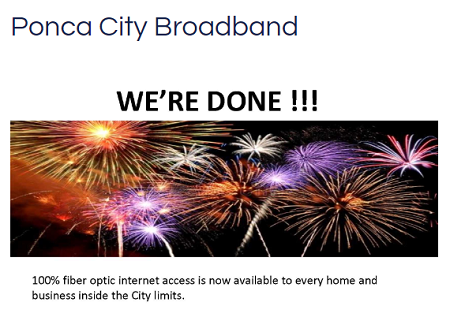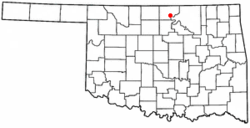
Fast, affordable Internet access for all.

Ponca City, Oklahoma officials say they’ve completed construction of a citywide fiber broadband network both ahead of schedule and under budget.
The finished network is now providing affordable, uncapped, multi-gigabit fiber access to every local resident in the community or 24,100 residents of Northern Oklahoma city.
In 1996, Ponca City began developing a 140 mile central fiber network to help connect schools, city offices, and other key anchor institutions. The city’s infrastructure was expanded in 2005 to provide access to local businesses, and again in 2007 when the city began providing local access to a citywide Wi-Fi system at no cost to local residents.
Frustrated with substandard service from regional telecom monopolies, in 2014 city officials began seriously talking about building a citywide fiber network. By 2015, officials had begun gauging local interest and found that 85 percent of residents were frustrated with existing service, and overwhelmingly supported the city’s plan to build something better.

That same year officials began network planning and studying other projects in earnest.
“Collectively we studied more than 2 dozen successful projects and 13 failed ones to learn from those experiences,” Dave Williams, Director of Technology Services for Ponca City said at the time. “We visited other cities that have implemented broadband solutions, read countless research articles detailing the challenges and rewards of such projects, and systematically took every aspect of this project apart and looked at it to develop a plan addressing all the potential problem areas the best we possibly could.”
‘Business is Booming’
Eight years later and those efforts are now paying off for Ponca City residents.
“We completely finished our construction in March, 2023–about 4 months ahead of schedule, and under budget,” Williams told ILSR. “Service is now available to every home and business inside the city limits–and business is booming,” he added.

All told, the city deployed more than 400 miles of new fiber throughout city limits. Williams said the final overall network build passed more than 10,103 traditional customer locations (residents and businesses).
The new network also passed another 3,520 “special” locations that provide connection points for several non-customers, including dark fiber for the city’s public schools, university center, and hospital, as well as fiber fed to city buildings, traffic and street light control cabinets, major intersection camera feeds, and 482 Wi-Fi radios to help feed the city’s Wi-Fi network.
The Ponca City Broadband project was financed through loans backed by cash reserves, several of which leaned on the kind of ultra-low interest rates briefly observed back in 2020. Originally projected to cost $20.4 million, Williams said he expects to have some money left over from the effort.
“We haven’t closed out all the contracts yet, but the funds to do so have been encumbered and there is nothing on the radar indicating there will be any overages–which left us with a budget surplus of just over $1.5 million.”
Popular, Home Grown Alternative To Monopoly Power
When it comes to equitable broadband, Oklahoma has never been a particularly solid performer.
Ookla speedtest rankings place Oklahoma somewhere around 41st in the US with median download speeds of 152Mbps, roughly 45 Mbps (Megabits per second) lower than the national average. Other estimates peg Oklahoma at 47th in the nation in terms of broadband connectivity, with around 30 percent of the state population deemed “underserved.”
Like so many communities, Ponca City sees a smattering of competition from companies like AT&T and Sparklight (CableONE), a company that has made it a top priority to block municipal broadband initiatives. Muted competition has meant muted efforts by regional giants to adequately serve the community, routinely resulting in high prices, long-term contracts, usage caps, and some of the worst customer service ratings of any industry in America.
Thanks to the city’s efforts locals now have access to three different fiber tiers at speeds most local incumbents (especially wireless or aging DSL lines) haven’t been able to match: a symmetrical 50 Mbps tier for $60 a month, a symmetrical 100 Mbps tier for $100 a month, and a symmetrical 1 gigabit per second (Gbps) tier for $250 a month.

Residents have to pay a $200 activation fee for service, which can be paid either up front in full, or for an additional $10 per month fee spread over 24 months. Unlike many incumbent broadband providers, the service comes with no usage caps or overage fees, and users don’t have to sign up for long-term contracts.
Williams told ILSR that the city is seeing a take rate somewhere around 21 percent of the total homes and businesses passed.
“Growth was slow at first, due to the small area service was available in,” he said. “Growth picked up as more and more customer service areas were operationalized–and sky-rocketed as we neared the end of the project.”
He added that city officials connected more new customers in the first two quarters of 2023 than in any full year prior to that. “We saw a slight slow-down in June, but July is already looking good again–the slowdown is most likely attributed to school being out, and family vacations,” he said.

Like many states, Oklahoma is laying the groundwork for how to spend an historic influx of federal broadband subsidies made possible by Covid relief and infrastructure legislation. The state’s freshly-created Oklahoma Broadband Office is currently developing a plan it hopes will deliver high speed broadband access to 95 percent of the state by June 2028.
According to the federal government, Oklahoma is slated to soon receive $797,435,691 in Broadband Equity And Deployment (BEAD) grants. State officials would be wise to look at the success of Ponca City, and other community-built cooperative, utility, and municipal fiber plans, as the backbone of bridging the digital divide.
As for other municipalities considering building their own fiber networks, Williams had plenty of advice.
“Use professional engineering and design firms, don’t try to do this yourself,” he said. “Prepare way ahead of time–lead times on materials is astronomical. Keep in mind that this is a competitive business, and the competition may undermine your efforts. Quality service is important … but customer service is critical.” But most importantly, he added, “Sit back and enjoy the end product!”
For more on the history and development of Ponca City Broadband, listen to David talk with Christopher on the Community Broadband Bits podcast below.
Header image of downtown Ponca City courtesy of Wikimedia Commons, Attribution 3.0 Unported (CC BY 3.0)
